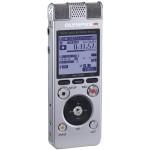 About a month ago, I purchased the Olympus DM-620 digital voice recorder in my ongoing quest to acquire the latest and greatest in nonvisually-accessible digital recorders. The Olympus DM-620 digital recorder is the latest in a line of Olympus digital recorders with voice guidance that makes most of the recorder’s settings and features nonvisually accessible. Other Olympus models that can be purchased with voice guidance are the Olympus DM-420, DM-520, DM-2, and DM-4.
About a month ago, I purchased the Olympus DM-620 digital voice recorder in my ongoing quest to acquire the latest and greatest in nonvisually-accessible digital recorders. The Olympus DM-620 digital recorder is the latest in a line of Olympus digital recorders with voice guidance that makes most of the recorder’s settings and features nonvisually accessible. Other Olympus models that can be purchased with voice guidance are the Olympus DM-420, DM-520, DM-2, and DM-4.
With the voice guided prompts, most of the recorder’s features are nonvisually accessible. It is still not possible to set the date and time without sighted help, and information about how much memory and/or recording time you have available is still not spoken, but the important settings can be adjusted with the help of voice guided prompts.
I needed a little bit of sighted help to install the batteries and to identify some of the buttons. However, after only a few minutes, I was able to operate the DM-620 and change settings on my own.
Pressing the Menu buttons starts the voice guidance which allows many recorder settings to be changed. The first thing that you will probably want to change is the speed of the voice prompts which, by default, are set to speak fairly slowly. Another setting that you might want to change is the format of the recording files. I prefer to use the MP3 format at 128KBPS.
The Olympus DM-620 provides five folders that can be used to hold audio recordings. They are labeled “Folder A,” “Folder B,” and so on. Each folder can hold up to 200 files (i.e., recordings).
I have found with some digital recorders that it is often a bit tricky to know which folder you are using. What I have done to overcome this problem is to record an audio file in each of the five folders stating the name of the folder. For example, in Folder A, I record a file which says “Folder A”. Then, I lock the file so that it cannot be erased accidentally. Files can be easily locked and unlocked through the menus, and all of this is accessible with voice guided prompts.
There is an electronic version of the User’s Guide for the Olympus DM-620, available as a PDF document: DM-620 Detailed Instructions (English). While much of this is readable with screen access technology, the file is formatted for visual presentation, and some of the information consists of unlabeled graphics. Nevertheless, I found that, with some effort, some useful information can be extracted from the PDF document.
All of the Olympus digital recorders I have used over the years have the ability to pause during recording and playback. This means that you can stop the recorder at any time to avoid recording any unwanted information or pause while listening to long recordings. Unfortunately, there seems to be no ability that I am aware of in the Olympus digital recorders with voice guidance to insert or add to recordings after they have been stopped.
All in all, I believe that the Olympus DM-620 is a very useful digital recorder, and it is reasonably accessible to the nonvisual user.
I was able to purchase this recorder on Amazon.com for about $126. (Currently listed on Amazon.com at $119.)
Contributed by Curtis Chong of Technology for the Blind
Follow us on Twitter, Like us on Facebook